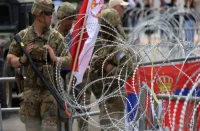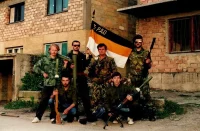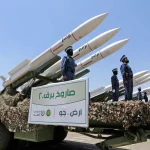A policy of the West European Great Powers in regard to the “Eastern Question” inclined in favor of protection of the territorial integrity of the Ottoman Empire, that means in favor of protection of the status quo at the Balkans.[1] On the other hand, the Balkan states, supported by Russia, had to finish their own process of national liberation and possible unification, which means to dissolute the Ottoman Empire. However, their wish to finish the process of national liberation was challenged by their own antagonistic nationalisms how to partition liberated territory from the Ottoman Empire. This problem had two main issues: historical and ethnic backgrounds of their territorial demands. Both of them became bases for their requirements over the territory of historic-geographic Macedonia. The crucial problem was to fix exact borders between the Balkan states after the military victory over the Ottoman Empire. All Balkan nations at that time accepted a German romanticist principle of creation of the national state: “One language-one nation-one state”.
However, practical implementation of this principle at the Balkans, especially in some regions like Macedonia or Bosnia-Herzegovina, became tremendously difficult for the reason that different nations (ethnolinguistic and ethnoreligious groups) lived mixed together as a consequence of migrations and historical development. The faith even today plays one of the crucial roles in ethnic or national identification among the Yugoslav and Balkan peoples and it will have a strong impact on their group’s identification in the future as well. Religious identity plays important role in defying the borders of ethnonational group because religious association is allied with the territorial aspect of the group identification. For that reason, the aspect of confession plays in many cases a pivotal role in fixing and demarcating the “national” living space, contributing at the same time to the image of the territory which has a particular (religious) character. However, the nationalism of the Balkan ethnic groups, being unable to fix clear ethnic and national-state borders, found in many historical cases as the best “solution” to “solve” the border problems: different types of “ethnic cleansing”, assimilation and exchange of the ethnic minorities.
The geopolitical background played also a significant role with regard to the “Macedonian Question”. Serbia as a continental state, being at the northern Balkans with the state borders on the Danube River, was under strong political, economic and cultural influence from Central Europe. Serbian foreign policy became completely changed after the Berlin Congress in 1878. Up to the Berlin Congress Serbian foreign policy was directed towards the west; in other words, towards Bosnia-Herzegovina with a final aim to annex this Ottoman province populated by Serb ethnolinguistic majority. However, after the Berlin Congress Serbian aspirations concerning territorial enlargement and national unification were forced to be redirected towards the south (as Austria-Hungary occupied Bosnia-Herzegovina) where the Ottoman Empire was in the process of internal dissolution and dismemberment. Serbia’s policy toward the “Macedonian Question” was characterized by three national and political-economic reasons:
- The first one was expressed in her desire to annex part of Macedonian territory, which was considered to be populated by the ethnolinguistic (Shtokavian speaking) Serbs;
- The second one was based on her desire to escape from political and economic patronage by Austria-Hungary by obtaining the exit to the Aegean Sea as Serbia’s exit to the Adriatic Sea by having a common border with Montenegro was halted and obviated by Austria-Hungary after 1878;
- The basic argument of those Serbs who claimed that the Macedonian Slavs (or one part of them) are ethnic Serbs is based on the fact that Slavic population from Macedonia has one typical Serbian national custom: the slava – a family celebration of the patron day when the family ancestor was converted to Christianity.
Similar territorial requirements and desires were present in political programmes of national unification by all other Balkan nations and states, as for instance in the case of Greece that was and is both Balkan and Mediterranean state. During the period of national revival, the Greek policy concerning territorial enlargement was fluctuating between the north and the south: in the other words, between the Balkan mainland and the Mediterranean Islands.
Bulgarian penetration (from the west) into Macedonia, in comparison to Serbian political-economic penetration (from the north) and Greek (from the south), was, however, strongest. Bulgarian foreign policy was mainly directed towards Macedonia. For Bulgarian foreign policy makers, the annexation of all Macedonia was the best instrument to prevent Serbia’s and Greece’s[2] attempts to have a common state border by division of Macedonia between themselves.[3] At the turn of a century, the (old) „Macedonian Question“ became the main apple of discord between the states of Serbia, Bulgaria, and Greece.
However, during the last decade of the 19th century an additional political factor emerged and took important place and a role in solving the “Macedonian Question”. It was Bulgaria’s sponsored Internal Macedonian Revolutionary Organization − IMRO, which worked under the slogan; “Macedonia for the Macedonians”. Officially, the IMRO was fighting either for 1. an autonomous status of Macedonia within the borders of the Ottoman Empire, or for 2. the political-administrative unification of the entire territory of historical and geographic Macedonia as an independent state, but with a final political aim to become a part of Bulgaria like the Eastern Rumelia became in 1885. Nevertheless, the IMRO was under strong Bulgarian political influence and financial sponsorship and in the course of time received visible Bulgarian national character. The Serbian official political circles rejected to recognize Macedonian autonomous status within the Ottoman borders fearing that such kind of autonomous Macedonia will be finally included into the borders of Bulgaria. The idea of San Stefano Bulgaria from March 1878 became a crucial fear for the Greek and Serbian territorial aspirations at the Balkans. In both Belgrade and Athens, especially after 1908, it existed a strong consternation that Bulgaria would incorporate whole Macedonia as she did with the Eastern Rumelia in 1885. In fact, Belgrade and Athens wanted to divide Macedonian territory between themselves and Bulgaria.[4]
The most eminent proponent of the concept of a United Macedonia became the IMRO either before the Balkan Wars of 1912−1913 or after Macedonia’s independence in 1991. Today, this party-movement under the current name of the “VMRO-DPMNE” (the Internal Macedonian Revolutionary Organization-Democratic Party for Macedonian National Unity) is politically working under the official slogan of “Spiritual and Territorial Unification of Macedonia”. In the case of territorial unification of entire geographical Macedonia into a single national state, the total population of such United Macedonia would be (according to the 1991 census) 4,5 million, as the population of the Bulgarian part of Macedonia is 400,000, while the population of both the Greek Macedonia and the FYR of Macedonia are approximately the same, a little more than 2 million each.
Final words
For the Balkan nations, territorial and national rights were always of much greater importance than human or civic rights. This historical fact became a milestone for the development of national ideologies among the Yugoslavs, who put on a pedestal of “national policy” the aim to transform ethnographical borders into the national-state borders. A period of the bloody destruction of the SFR of Yugoslavia followed by the inter-ethnic conflicts in Kosovo-Metochia and the FYR of Macedonia (1991−2001) is a typical example of such national policy based on the idea of creation of a united national state, if possible, without the ethnic minorities.
Reposts are welcomed with the reference to ORIENTAL REVIEW.
[1] For the matter of time comparison, see: Michail E., “Western Attitudes to War in the Balkans and the Shifting Meanings of Violence, 1912−1991”, Journal of Contemporary History, Vol. 47, № 2, 2012, pp. 219−239.
[2] From the Greek point of view, ethnic Slavs who are living within the borders of present-day Greece are understood and officially recognized as the “Slavophone Greeks”.
[3] According to the Serbian-Bulgarian Agreement reached on March 3rd, 1912 against the Ottoman Empire the territory of Macedonia was to be shared among themselves in the following way:
- All territory of Macedonia that was eastwards from the Mt. Rhodope and the River of Struma will be annexed by Bulgaria;
- Serbia would annex all portion of “liberated territories” from the Ottomans westwards and northwards from the Mt. Shara;
- The central portion of Macedonia, between the Mt. Rhodop and Mt. Shara, was proclaimed as a “contested territory”.
However, Belgrade and Sofia preliminary divided this disputed zone (“contested territory”) of Macedonia by drawing a delimitation line that was running from the Lake of Ohrid to Kjustendil between Skopje and Veles. According to the agreement, Serbia will not claim the territories southwards from this line, while Bulgaria will accept a demarcation line arbitrated by the Russian Emperor (“Treaty of Friendship and Alliance between the Kingdom of Bulgaria and the Kingdom of Serbia with the secret Appendix”, Sofia, February 29th (old style), 1912, in Trifunovska S. (ed.), Yugoslavia Through Documents. From its creation to its dissolution, Dordrecht-Boston-London: Martinus Nijhoff Publishers, 1994, pp. 114−117). Similar to this case from the beginning of the 20th century at the end of the same century there were ideas of division of Macedonia among Serbian politicians. Thus, for instance, Vojislav Šešelj, a leader of the ultra-right Serbian Radical Party favored the partition of the FYR of Macedonia between Serbia and Bulgaria with small areas given to Albania. There were Serbs who suggested in 1992 to the Greeks to be established a common Greek–Yugoslav border by dividing the territory of the FYR of Macedonia between Greece and the FR of Yugoslavia.
[4] See: Aarbakke V., Ethnic Rivalry and the Quest for Macedonia 1870−1913, Copenhagen, 1992; Poulton H., Who are the Macedonians, London, 1995; Brailsford H. N., Macedonia. Its Races and their Future, New York, 1971; Adanir F., Die Makedonische Frage: Ihre Entstehung und Entwicklung bis 1908, Wiesbaden, 1979. In this case, Serbia and Greece will have a common state border, but Bulgaria and Albania will not have a common state border what was the main political aim of Macedonian policy by Belgrade and Athens.














Comments